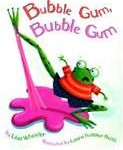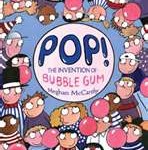 In a recent Remenar Seminar, a principal pointed out that I share lots of stories, but not a lot of non-fiction. That’s something I’m working on – I love fiction, but I know many learners really respond to informational text. So, I’m trying to pair up books on irresistible topics – like bubble gum!
In a recent Remenar Seminar, a principal pointed out that I share lots of stories, but not a lot of non-fiction. That’s something I’m working on – I love fiction, but I know many learners really respond to informational text. So, I’m trying to pair up books on irresistible topics – like bubble gum!
I’m stuck on the bouncy rhyme of Lisa Wheeler’s Bubble Gum, Bubble Gum: “chewy-gooey bubble gum/ icky-sticky bubble gum/ melting in the road/ along comes a toad” who gets stuck. Then a shrew gets stuck, and more animals get stuck – until a truck comes along! What will they do? Chew! And blow a bubble that lifts them from danger, until…
This makes a terrific storybox. Put this book, with its great illustrations by Laura Huliska-Beith, and puppet characters on wooden sticks in the storybox with a container of homemade pink playdough (make sure it’s non-toxic because one of your sweetpeas will probably try chewing on it) to retell the story.
 Then, share Pop! The Invention of Bubble Gum by Megan McCarthy. It is excellent non-fiction for younger students. The topic is sure to grab their attention, the text is short but interesting and full of fun facts, and the illustrations are large enough for a group read. At the end of the book, McCarthy adds lots more information (like who holds the world record for largest bubble) for kids who want to really sink their teeth into the subject.
Then, share Pop! The Invention of Bubble Gum by Megan McCarthy. It is excellent non-fiction for younger students. The topic is sure to grab their attention, the text is short but interesting and full of fun facts, and the illustrations are large enough for a group read. At the end of the book, McCarthy adds lots more information (like who holds the world record for largest bubble) for kids who want to really sink their teeth into the subject.
Want a super-duper Dubble Bubble science extension? Ask your students, “Do you think bubble gum will weigh more or less after you chew it?” Use the scientific method of forming a hypothesis, listing materials and procedure, controlling variables (everyone chews the same kind of gum for the same amount of time), and see what your results are!